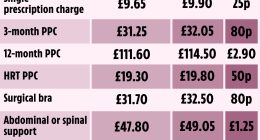The following is an excerpt from Grow Your Business: Scaling Your Business for Long-Term Success by the staff of Entrepreneur Media and Eric Butow, on sale now.
There are always smaller competitors waiting to take your market share, and it’s only a matter of time before you transition from the hunter into the hunted. So you need to think of scaling not just in terms of company growth, but also as a way to build all the elements that make up your value proposition, so that you’re as competitive as possible.
In the choice between growth and scaling, one option isn’t better than the other. You have to decide what works best for you, based on your industry and your company’s situation. What you do need to understand is why you have chosen one approach over the other and how you will leverage your growth with your other competitive factors, such as having the most product features of any company in your market.
Grow Your Business: Scaling Your Business for Long-Term Success is available now at Entrepreneur Bookstore | Amazon | Barnes and Noble
Applying Scaling to Your Small Business
Let’s say you’re a small business that has made the decision to scale. Before you start putting together your plans and processes, you need to understand the fundamental drivers of scalability, which are divided into three categories: scalable market, scalable business, and scalable team. Then you can analyze your business using these drivers.
Scalable Market
In the scalable market category, analyze the size of the market, the economics required to scale, and the rate of market growth.
Total Addressable Market (TAM): The market needs to be big enough that you can meet or exceed your growth targets. A rule of thumb is that TAM must be at least four times your business size goal. For example, if you want to build a $10 million business, then total sales in the market need to be at least $40 million.
Profit: Investing in the tools and people you need to succeed is expensive. Is the target market profitable enough to support not only your investments now but also your future growth? And do you have the measurement tools in place to find out?
Growth: The market needs to be growing, too, and preferably faster than the rate of new competitors entering the market.
Grow Your Business: Scaling Your Business for Long-Term Success is available now at Entrepreneur Bookstore | Amazon | Barnes and Noble
Scalable Business
Understand what your business has to offer so you can not only become the market leader, but also stay in that position, despite your competitors’ best efforts.
Be number one: You must scale with the intention of being the leader in your market or a sizable niche within that market.
Channels to market: Your scalable business needs access to channels with customers whom you can target, market to, and sell to profitably.
A scalable operating model: Your business must have unconstrained access to all critical materials and talent without breaking your bank account. In the post–COVID-19 economy, finding that access has been more challenging than previously.
Scalable economics: Calculate the scalability of your economics with this formula: [Gross profit per $1 million new revenue] divided by [new cost required to manage each $1 million of new revenue]. New cost includes assets like people, technology, and facilities. For example, if your gross profit per $1 million is $100,000 and the new cost is $50,000, the ratio is 2. If you have a ratio of 2 or greater, you have a highly scalable business. Anywhere between 1 and 1.2 means you’ll feel like you’re climbing El Capitan. If the ratio is below 1, you don’t have a scalable business. If you’re between 1.2 and 2, then you have a better chance of creating a scalable business with the right adjustments.
Your it factor: The market you’re in is likely very competitive, so you need to identify what makes you stand apart from the rest. Those differentiators must be good enough to keep you on top of your market or market niche.
Scalable Team
You need to be a scalable business owner to scale your business. Consider whether you’ll be able to:
- Build a great culture, especially one with more than 100 people
- Build a quality team of senior leadership and delegate large parts of the business to them
- Transition smoothly from entrepreneur to builder and manager Act in the best interests of the business, not yourself
- The most painful stage is going from 10 employees to 100 because that’s when you’re changing from a small business to a professionally managed company. If you can hire great managers to help you run the business and let you be an effective leader, that’s a good sign you’ll be able to scale your business further.
Related: The Tactics Great Leaders Use to Focus Their Mindset on Growth
8 Strategies to Scale Your Small Business
The strategies you’ve used to grow your business thus far will help you build a scalable business, too. Those strategies include:
- Building a sales funnel. It will automate your sales process and help you scale more easily. Implementing a CRM system. That way you don’t have to track transactions manually, which can become overwhelming as the company gets larger. There are plenty of CRM systems out there. You can view a list and compare them on the Capterra website.
- Researching the competition. Find out how they market to and acquire new customers so you can use some of their strategies and exploit their weaknesses. You can also learn about competitive intelligence software at Capterra to help you find and compare solutions.
- Creating a customer loyalty program. It costs more money to acquire a new customer than it does to sell to an existing customer. So once you have a customer, do everything you can to keep them.
- Identifying opportunities. To find the right opportunities, you need to understand everything from your distribution channels to your direct competitors. As you analyze what’s happening in your market, you’ll likely find other possibilities you can pursue now or down the road.
- Building an email list by offering a lead magnet. This could be a free document that potential customers find valuable. Once you’ve built a list, you can work with a company that provides email marketing services to handle the logistics, such as Mailchimp or Constant Contact.
- Creating multimedia offerings. Use videos on YouTube, Instagram, and TikTok to sell your product or service. Webinars are also a great way to reach a wide audience.
- Leveraging existing platforms. For example, you may want to look into selling your products on Amazon and eBay. However, be careful when you sell on such platforms, because their top priority is their bottom line, not yours.
- Diversifying your offerings. Always look out for ways to add complementary products, services, or information to your primary product or service. When you add value to the exchange, you’ll see more income.
For more growth strategies, pickup Grow Your Business: Scaling Your Business available now at Entrepreneur Bookstore | Amazon | Barnes and Noble
This article is from Entrepreneur.com










